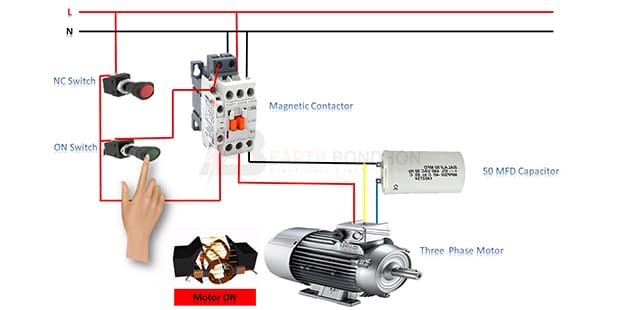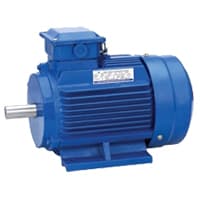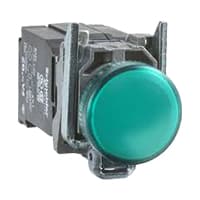3 phase Motor on Single Phase:
This Diagram shows how to run a 3-phase motor on a single-phase supply. In this circuit diagram, we use a 3-phase motor, a 50 MFD capacitor, a magnetic contactor, an NC switch ( Normal Close ), and a NO switch ( Normal Open ). First, we input the power line to the magnetic contactor and NC switch, then from the NC switch to the NO switch, then connect the magnetic contactor, switch, motor, and capacitor as in the image. If you want to know more about this circuit and want to see the connection of this circuit please check our youtube video link below.
Advertisements
Components needed For this Project:
You can get the components from any of the sites below:
- Magnetic Contactor 25A [See Buy Click Amazon]
- 50 MFD Capacitor (220V ac Line) [See Buy Click Amazon]
- Single Phase Motor (1 HP) [See Buy Click Amazon]
- Push Button NC Switch [See Buy Click Amazon]
- Push Button NO Switch [See Buy Click Amazon]
*Please note: These are affiliate links. I may make a commission if you buy the components through these links. I would appreciate your support in this way!
Advertisements
Components used to make the 3-phase Motor on Single Phase:
A magnetic contactor is an electromagnetic switching device. It is generally used for controlling 3-phase Motors. The operation of a magnetic contactor is similar to that of a Relay. but a relay is used for low-power or low-voltage connections, and a magnetic contactor is used for high-power or high-voltage connections. As soon as the supply is applied to the magnetic contactor coil. its normally open contacts are closed and normally closed contacts are opened and the associated devices are also operated. This is how a magnetic contactor works.
02. 50 MFD Capacitor:
Motor Starting Capacitors are used during the Motor Startup Phase and are Disconnected From the Circuit once the Rotor Reaches a Predetermined Speed, Which is Usually about 75% of the Maximum Speed for that Motor type. These Capacitor Usually Have Capacitance Values Of Over 70 UF. The Starting capacitor creates a Current-to-Voltage lag in the Separate start Windings of the Motor. Starting Capacitor are Wired into The Auxiliary Winding Circuit of the Motor and are Disconnected from the main winding circuit by the Centrifugal Switch once the Motor has Reached a Predetermined Speed.
A 3-phase electric motor uses a 3-phase Power Supply to Convert Electric Energy into Mechanical Energy. It contains four Wires (Three hot Wires and one Neutral Wire) and Uses 3 Alternating Currents of the Same Frequency. Since it Generates a Rotating Magnetic Field, it does not need a Capacitor for the Startup. Some 3-phase Motors are Reversible, Which Means they can serve as Generators by Turning Mechanical Energy into Electrical Energy.
04. NC Switch:
An NC (Normally Closed) Push Button is a Push Button That, In Its Default State, Makes Electrical Contact With The Circuit. An NC (Normally Closed) Push Button is a Push Button that, in its Default State, Makes electrical Contact With the Circuit. When The Button Is Pressed Down, The Switch no Longer Makes Electrical Contact And The Circuit is Now Open. When The Button is Not Pressed, Electricity Can Flow, But When it is Pressed The Circuit is Broken. This type Of Switch is Also known As a Normally Closed (NC) Switch.
NO (Normally Open) Terms Refer to a Type of Dry Contact or Wet Contact. A Push to Make Switch Allows Electricity to flow Between its 2 contacts when held in. When the button is released, the Circuit is broken. This type of Switch is also known as A Normally Open (NO) Switching system. As its name implies, a Normally Open (NO) Switch Contact or “a Contact” is a Switch. Put very simply, a Normally Open Sensor will have no Current When in a Normal State But When it Enters an Alarm State it will have +5V applied to the Circuit.
Thank You for visiting the website. Keep visiting for more Updates.
Frequently asked questions
Most three-phase motors can be configured to run on 208, 220/240, and 440/480. The current flow draw will be different at each setting, requiring different wire sizes to work properly.
One common approach is to use a single-phase transformer, which can be connected to two of the three phases of the 3-phase system to create a single-phase output. Another method involves using a rotary phase converter, which uses capacitors and inductors to create a single-phase output from the 3-phase input.
Ok, if there are 3 phases 220 volts, all you have to do, is cap one of the phase wires. Use the two remaining phase wires and the ground and you will have 220 V single phase. AssuredElectrical: The Breaker will still trip if needed and it will work with only the 2 phases connected.
For these situations, we have three-phase to single-phase isolation transformers, these devices are used to convert the electrical energy from a three-phase system to a single-phase system in an efficient and economical way, thus being able to go from 3 phases of 400V to 2 phases of 230V.
But to have 220 Volt the NEUTRAL is a must between each phase and the neutral would give you 220 V. This system is called 3-phase 220 V. Unlike the 220 V 3-phase, you don't need a neutral, with a good GROUND will give you 220 Volt.
Read more Single Phase Wiring
What is a kilowatt-hour (kWh) | kwh formula | What does kwh mean
Introduction to Electrical Units and CircuitskW and kWh on your electricity bill As your home uses electricity during...
What is the Difference Between kVA | What does KVA mean | kVA formula
Difference Between KVA ExplainedWhat does KVA Mean? There are technical terms aplenty when it comes to generators, and...
Power Factor | Power Unit | Energy | Electricity Unit
Power factor definition | Calculating Power FactorPower Factor Values In a purely resistive circuit, the power factor...






0 Comments